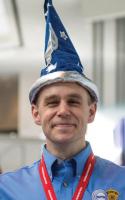Resonance: Breaking Barriers and Symmetries
Spring
2017
The Director's Space
Resonance: Breaking Barriers and Symmetries
Brad R. Conrad, PhD
 The 2016 Physics Congress (PhysCon) has come and gone, leaving us with not only fond memories but also something unique: a sense of community and direction in a time when unifying forces are hard to come by. At PhysCon, Sigma Pi Sigma, with support from the Society of Physics Students, the American Institute of Physics, and others, brought together the largest collection of students, mentors, and supporters we have ever seen. The singular fact that this event hosted over 40 percent more people than in 2012 is enough for me to realize how truly remarkable 2016 was for us as a community. Not only were we better represented than ever before, coming from many walks of life and backgrounds, we formed a congress in the truest sense of the word.
The 2016 Physics Congress (PhysCon) has come and gone, leaving us with not only fond memories but also something unique: a sense of community and direction in a time when unifying forces are hard to come by. At PhysCon, Sigma Pi Sigma, with support from the Society of Physics Students, the American Institute of Physics, and others, brought together the largest collection of students, mentors, and supporters we have ever seen. The singular fact that this event hosted over 40 percent more people than in 2012 is enough for me to realize how truly remarkable 2016 was for us as a community. Not only were we better represented than ever before, coming from many walks of life and backgrounds, we formed a congress in the truest sense of the word.
Through your support, attendees heard from visionaries within our field, explored companies and laboratories that are changing our world, and connected with one another in ways we never expected. Despite being diffuse in background, we broke through barriers and found common concerns, interests, and fellowship. These symmetries help to not only define us as physicists and astronomers but also define what we value as a society and community. Over three short days, progress was made on the ways we can improve ourselves, our local communities, and the world around us.
The ideas of solving problems collectively to improve our future, building connections to form an inclusive community, and being interdisciplinary in our endeavors resonated strongly with the attendees. This resonance only happened because we came together and acted as a community: embracing the attributes and experiences that differentiate us as well as the interests and concerns that unify us. By continuing to work together, we can impact the physics and astronomy communities as a whole—one student, one class, and one conference at a time.
Without ∑∏∑, there would not be a meeting specifically for undergraduate physics and astronomy students and alumni, and the community, as a whole, would be worse for it. ∑∏∑ enabled a record number of students to act as a congress and helped build the foundation of our future. For this I cannot thank you enough. I can, however, promise to help this happen again, a little bit sooner, in 2019.

